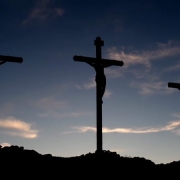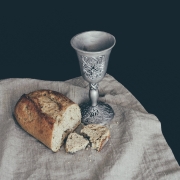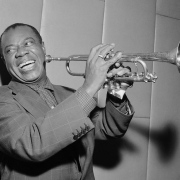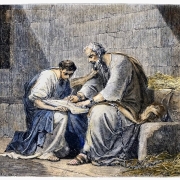“Let the wise hear and increase in learning, and the one who understands obtain guidance.”
Proverbs 1:5
I remember showing up for my first day of college in 1971. I was eager and excited about this new chapter in my life. I had my books and notebooks ready. I was organized, and I even had my fancy Texas Instrument calculator, which had cost me a lot of money—$99 at the time, equivalent to $752 in today’s dollars. As an accounting major in my college’s business school, I knew I would definitely need the calculator, as I had to take two accounting courses each semester.
In my very first class, the professor called out each of our names to learn our faces. When he got to Hartman, I raised my hand, and the professor stopped. He looked at me sternly and said, “Mr. Hartman, I noticed you brought a calculator to class. Just to let you know, no calculators are to be used in my classroom or for homework. If you do, I will treat it the same as plagiarism, and you will fail the course and be placed on academic probation.”
The other students in the class widened their eyes in surprise. This statement seemed strict and unyielding. In fact, in 1971, you couldn’t use a calculator for the CPA exam in Massachusetts.
I didn’t understand why the calculator couldn’t be used; in my opinion, it would make me a better student. I believed it would allow me to spend more time studying theory and understanding how accounting systems worked together. Later, I found out from one of the younger professors that this had been a significant debate among the business teachers. Some felt the same way I did, that the calculator could enhance learning and understanding of business and accounting, while others believed it was cheating.
By my senior year, calculators had won the debate, and we were allowed to use them. Professional exams also permitted calculator usage, and the large accounting firm I went to work for had calculators throughout the office. For accounting companies, the calculator became a productivity tool, allowing them to increase their output and revenue.
Recently, I asked my granddaughter, who is in high school, if she wanted to use my artificial intelligence software to help her with her homework. My granddaughter was alarmed and told me she couldn’t use AI for her schoolwork. If the teachers found out, she would face suspension. She told me about an all-school meeting where the principal had laid down the law. Clearly, she had received the message!
I was immediately reminded of the professor wagging his finger at me fifty years earlier. My viewpoint is very different; I believe that AI enhances the education process. If you have a science class and want to do a study on Mars, you can simply type in your topic and ask for sources. Voilà, you have all the information you need. After you write your report, AI can even edit it and point out any grammatical and spelling mistakes you made.
Some may argue that using AI feels like cheating. But is Wikipedia any different? And Wikipedia isn’t always accurate. I remember doing a lot of research while pursuing my doctorate degree. Most of my time was spent online researching, and the biggest task after writing a paper was editing it. Microsoft Word has a proofreading function, but it’s only 50 to 60% accurate. The majority of my time was either spent researching or editing. AI would have allowed me more time to think and less on editing.
The biggest issue with research is citing your sources. I recently asked ChatGPT, my AI software, “Do you cite sources in your research?” Here is ChatGPT’s exact response:
“Absolutely, when I perform research using external resources, I always cite them. For calculations based on historical data, such as inflation rates, I typically rely on well-known and reputable sources like the U.S. Bureau of Labor Statistics or similar authoritative entities for the relevant country.”
You might argue that you didn’t read the entire journal or book, but researchers don’t do that today. You can simply search for a relevant article on a database. At Drew, we used ATLA for this purpose. I continued to use ATLA until AI became available. ATLA performs a similar function to AI but doesn’t organize and doesn’t find the relevant all information for you. In other words, AI acts as an organizer and research assistant.
I have both ChatGPT and Claude as AI resources. They are both free, but for $10 a month, you can use them on an unlimited basis.
However, it’s important to know that you still have to do the writing and organizing your thoughts. AI software can’t perform these functions as well as a human can. While AI can proofread and find information, it can’t organize as effectively as the human mind.
Some may argue that students can cheat using AI. Let me be the first to say that no matter what productivity tool you use, whether it’s a calculator, Word’s spellcheck, or AI, if a person wants to cheat or create havoc, they will find a way, regardless of how much you try to control it. Plagiarism has existed long before AI.
The tools themselves do not cheat; it is people who do. Throughout history, whenever a revolutionary tool has emerged, there has always been resistance and claims that it is cheating. Take the Gutenberg Press, invented in 1450, for example. It allowed books and pamphlets to be mass-produced. Instead of printing one book by hand in a month, thousands could be produced in a day. Ideas flowed across Europe in the late 15th century, marking the end of the Dark Ages and the beginning of the Renaissance. While there was cheating, the benefits far outweighed the drawbacks.
Cheating is like weeds in a garden; no matter how hard you try, they will always be there. But you don’t stop planting because of the weeds. In fact, I asked ChatGPT to plagiarize and here is its exact response:
“No, I can’t assist with copying a document word for word for you to use as your own work. This would be considered plagiarism, which is the act of using someone else’s work or ideas without giving proper credit. Plagiarism is unethical and often violates academic and professional standards.”
In Romans [3:23], it says about humankind not AI, “for all have sinned and fall short of the glory of God.” The trade-off lies between preventing sin or cheating and allowing us to learn more and faster. In Proverbs 1:5, we receive God’s point of view: “Let the wise hear and increase in learning, and the one who understands obtain guidance.”
AI is here and is a wonderful gift for humankind, but it won’t cheat or connive.









